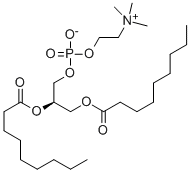1-[CIS-9-OCTADECENOYL]-2-HEXADECANOYL-SN-GLYCERO-3-PHOSPHOCHOLINE
- CAS NO.:59491-62-2
- Empirical Formula: C42H82NO8P
- Molecular Weight: 760.08
- MDL number: MFCD00674332
- Update Date: 2023-05-04 17:34:40
![1-[CIS-9-OCTADECENOYL]-2-HEXADECANOYL-SN-GLYCERO-3-PHOSPHOCHOLINE Structural](https://img.chemicalbook.in/CAS/GIF/59491-62-2.gif)
What is 1-[CIS-9-OCTADECENOYL]-2-HEXADECANOYL-SN-GLYCERO-3-PHOSPHOCHOLINE?
The Uses of 1-[CIS-9-OCTADECENOYL]-2-HEXADECANOYL-SN-GLYCERO-3-PHOSPHOCHOLINE
1-Oleoyl-2-palmitoyl-sn-glycero-3-phosphocholine is used in the pharmaceutical formulation for the prodn. of antiviral medication effective for dengue and zika.
Definition
ChEBI: 1-oleoyl-2-palmitoyl-sn-glycero-3-phosphocholine is a phosphatidylcholine 34:1 in which the two acyl substituents at positions 1 and 2 are specified as oleoyl and palmitoyl respectively. It is a phosphatidylcholine 34:1 and a 1-acyl-2-hexadecanoyl-sn-glycero-3-phosphocholine. It is functionally related to an oleic acid.
General Description
Phosphatidylcholines (PCs) are mainly located on the outer leaflets of the biological membrane?bilayer.
Biochem/physiol Actions
Phosphatidylcholine?(PC) can form a hydrophobic surface in the mucus by acting as a surfactant to inhibit the penetrance of bacteria.
Properties of 1-[CIS-9-OCTADECENOYL]-2-HEXADECANOYL-SN-GLYCERO-3-PHOSPHOCHOLINE
| storage temp. | -20°C |
| solubility | Ethanol: 25 mg/ml |
| form | A crystalline solid |
Safety information for 1-[CIS-9-OCTADECENOYL]-2-HEXADECANOYL-SN-GLYCERO-3-PHOSPHOCHOLINE
| Signal word | Danger |
| Pictogram(s) |
 Skull and Crossbones Acute Toxicity GHS06  Health Hazard GHS08 |
| GHS Hazard Statements |
H302:Acute toxicity,oral H315:Skin corrosion/irritation H319:Serious eye damage/eye irritation H331:Acute toxicity,inhalation H336:Specific target organ toxicity,single exposure; Narcotic effects H351:Carcinogenicity H372:Specific target organ toxicity, repeated exposure |
| Precautionary Statement Codes |
P202:Do not handle until all safety precautions have been read and understood. P301+P312:IF SWALLOWED: call a POISON CENTER or doctor/physician IF you feel unwell. P302+P352:IF ON SKIN: wash with plenty of soap and water. P305+P351+P338:IF IN EYES: Rinse cautiously with water for several minutes. Remove contact lenses, if present and easy to do. Continuerinsing. P308+P313:IF exposed or concerned: Get medical advice/attention. |
Computed Descriptors for 1-[CIS-9-OCTADECENOYL]-2-HEXADECANOYL-SN-GLYCERO-3-PHOSPHOCHOLINE
New Products
(S)-3-Aminobutanenitrile hydrochloride 4-Methylphenylacetic acid N-Boc-D-alaninol N-BOC-D/L-ALANINOL Tert-butyl bis(2-chloroethyl)carbamate 3-Morpholino-1-(4-nitrophenyl)-5,6-dihydropyridin- 2(1H)-one Furan-2,5-Dicarboxylic Acid Tropic acid 1-Bromo-3,5-Di-Tert-Butylbenzene S-2-CHLORO PROPIONIC ACID ETHYL ISOCYANOACETATE 2-Bromo-1,3-Bis(Dimethylamino)Trimethinium Hexafluorophosphate 4-IODO BENZOIC ACID 3-NITRO-2-METHYL ANILINE 1-(2,4-DICHLOROPHENYL) ETHANAMINE (2-Hydroxyphenyl)acetonitrile 4-Bromopyrazole 2-(Cyanocyclohexyl)acetic acid 4-methoxy-3,5-dinitropyridine 1-(4-(aminomethyl)benzyl)urea hydrochloride 2-aminopropyl benzoate hydrochloride diethyl 2-(2-((tertbutoxycarbonyl)amino) ethyl)malonate tert-butyl 4- (ureidomethyl)benzylcarbamate Ethyl-2-chloro((4-methoxyphenyl)hydrazono)acetateRelated products of tetrahydrofuran








You may like
-
 18:1-16:0 PC CAS 59491-62-2View Details
18:1-16:0 PC CAS 59491-62-2View Details
59491-62-2 -
 18:1-16:0 PC CAS 59491-62-2View Details
18:1-16:0 PC CAS 59491-62-2View Details
59491-62-2 -
 1-Oleoyl-2-palmitoyl-sn-glycero-3-phosphocholine CAS 59491-62-2View Details
1-Oleoyl-2-palmitoyl-sn-glycero-3-phosphocholine CAS 59491-62-2View Details
59491-62-2 -
 18:1(n9)-16:0 PC - IsoPure CAS 59491-62-2View Details
18:1(n9)-16:0 PC - IsoPure CAS 59491-62-2View Details
59491-62-2 -
 1975-50-4 98%View Details
1975-50-4 98%View Details
1975-50-4 -
 2-HYDROXY BENZYL ALCOHOL 98%View Details
2-HYDROXY BENZYL ALCOHOL 98%View Details
90-01-7 -
 14714-50-2 (2-Hydroxyphenyl)acetonitrile 98+View Details
14714-50-2 (2-Hydroxyphenyl)acetonitrile 98+View Details
14714-50-2 -
 118753-70-1 98+View Details
118753-70-1 98+View Details
118753-70-1
Statement: All products displayed on this website are only used for non medical purposes such as industrial applications or scientific research, and cannot be used for clinical diagnosis or treatment of humans or animals. They are not medicinal or edible.